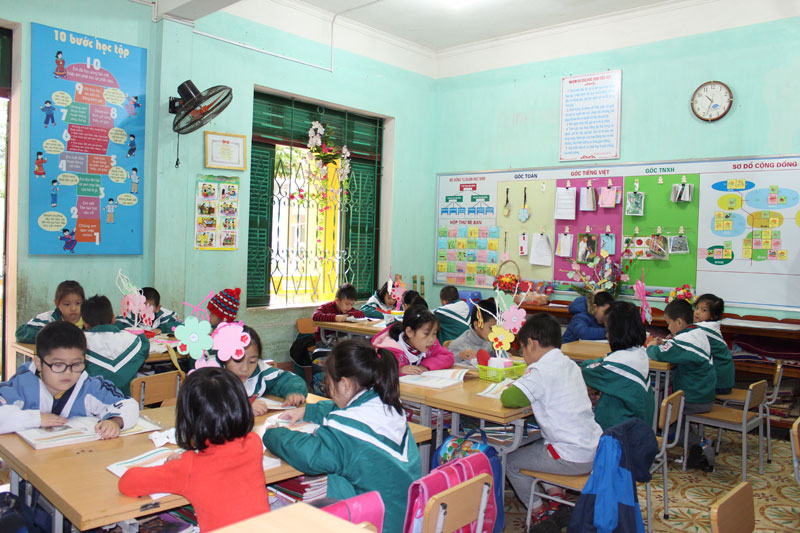
(HBO) – Being a province with 70% population of ethnic minority people, Hoa Binh Department of Education and Training pays special attention to teach Vietnamese and ethnic minority languages.
A Vietnamese lesson of pupils at Mai Chau Town Primary School (Mai Chau).
Mr. Nguyen Duc Luong, The Deputy Director of Education and Training Department confirmed: To continue implementing the Instruction No. 38 on November 29th, 2004 of Prime Minister about strengthening training and fostering ethnic minority languages, the Department has guided all the general education institutions and vocational training centers to organize classes, assessing and giving certificates of ethnic minority languages. In the school year of 2016-2017, The Department of Education and Training organized clases, assessed and gave certificates of Mong and Thai ethnic languages for 213 staffs, officials and teachers in the province area. This helps staffs, officials and teachers become more active and confident in their work at the ethnic minority area.
Especially, on September 8th, 2016, the provincial People’s Committee announced the Decision No. 2295/QD –UBND about approving Muong ethnic letter system in Hoa Binh. This means that the Muong letter system includes 28 letters, 24 first consonants, 1 accompanied sound. To make Muong ethnic language popular in the social life, on October 27th, 2016, the provincial People’s Committee promulgated the Plan No. 118 to exploit the application of Muong ethnic letter system in Hoa Binh province. One of the most typical features of this plan is to design a textbook of learning Muong language which was approved by the authorized office, then organize teaching and learning Muong ethnic language for all people levels in the province. Based on the provincial plans, the Department of Education and Training guided the staffs, officials and teachers in all units and schools to strengthen self-study, foster ethnic minority languages. All the units and schools connect the content of self –studying and fostering the ethnic minority languages closely with fostering regularly for staffs and teachers. All the staffs and teachers have set up plans for self- studying, self- fostering ethnic minority for their teaching and communication with pupils’ parents.
Together with teaching ethnic minority languages, the Department of Education and Training has taken care of teaching Vietnamese for ethnic minority pupils. It has continuously strengthened to implement content of Vietnamese preparation and Vietnamese strengthening for ethnic minority pupils (kindergartens, primary schools) which is relevant to the local situation. On March 10th, 2017, the Department of Education and Training issued the Documentary No. 573 about "Strengthening Vietnamese for ethnic minority children at kindergartens”. For Grade 1 of Ethnic Minority, strengthen Vietnamese in the direction of Ministry of Education and Training”.
The Department has well implemented teaching Vietnamese for ethnic minority pupils in the direction of increasing the amount of learning Vietnamese time by learning 2 lessons/ day or have an extra lesson/ week. 100% schools have organized Vietnamese preparation course for children before Grade 1 (in the summer fostering course). Besides, schools held extra 1-2 Vietnamese classes for children every week, which contributes to improve the general education quality and national education quality.
Especially, the provincial Department has directed all the schools, especially the schools of Hang Kia commune, Pa Co commune of Mai Chau district (with 100% population of Mong people) strengthen the time of teaching Vietnamese for ethnic minority children in the integrating way into school subjects, extra outdoor activities. Schools and teachers usually collaborate with communities and parents to create communicating environment of Vietnamese for ethnic pupils. It really increases the education quality, and cultural knowledge in ethnic minority area.
With just over a month left until the school summer break, students are eagerly anticipating a period of rest and fun after a year of academic pressure. To provide a healthy environment for the physical development, in addition to the classes that foster talents and enhance the academic knowledge, sports and physical activities continue to attract a large number of children and teenagers.
On April 17th, Hoa Binh Provincial Museum organized a program to promote and introduce the outstanding values of "Hoa Binh Culture” at the Boarding Secondary and High School for ethnic minority students in Mai Chau District.
The Hoa Binh College of Technical Technology, in collaboration with the Hoa Binh Technical and Economic College and the provincial Association of Literature and Arts, hosted a gathering on April 15 to celebrate Laos’ traditional Bunpimay (New Year) Festival 2025 and debut the new book "Nguoi Muong o ban Don” (Muong people in Don village).
In the millennia-long history of national construction and safeguarding, people of all ethnic groups in Hoa Binh have been united and closely bound together to overcome all difficulties and challenges, standing alongside the entire Vietnamese people throughout the history of building and defending the country.
Living green is a healthy, positive, and sustainable lifestyle that not only helps protect
the environment and quality of life but also conserves natural resources and ecosystems.
Among the many ways to embrace this lifestyle, reducing plastic consumption is one of the most impactful.
The women's unions at all levels in Kim Boi district have been making significant contributions to the movement of building cultural life in the local community.
The movement helps improve rural look and the spiritual and material lives of local residents.



